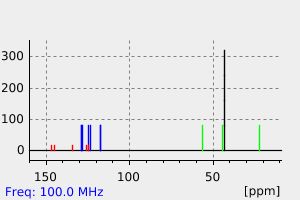chlorpromazine | 67635-59-0
中文名称
——
中文别名
——
英文名称
chlorpromazine
英文别名
3-(2-chloro-10H-phenothiazin-10-ium-10-yl)-N,N-dimethylpropan-1-amine
CAS
67635-59-0
化学式
C17H19ClN2S*H
mdl
——
分子量
319.878
InChiKey
ZPEIMTDSQAKGNT-UHFFFAOYSA-O
BEILSTEIN
——
EINECS
——
-
物化性质
-
计算性质
-
ADMET
-
安全信息
-
SDS
-
制备方法与用途
-
上下游信息
-
文献信息
-
表征谱图
-
同类化合物
-
相关功能分类
-
相关结构分类
计算性质
-
辛醇/水分配系数(LogP):5.2
-
重原子数:21
-
可旋转键数:4
-
环数:3.0
-
sp3杂化的碳原子比例:0.29
-
拓扑面积:33
-
氢给体数:1
-
氢受体数:2
反应信息
-
作为反应物:描述:chlorpromazine 在 peroxomonosulfate(1-) 作用下, 以 水 为溶剂, 生成 chlorpromazine radical cation参考文献:名称:吩噻嗪及其自由基阳离子在水溶液中的单电子转移反应的停流动力学研究摘要:通过停流分光光度法研究了质子化形式的吩噻嗪,即氯丙嗪 (CPZH+) 和异丙嗪 (PMZH+) 与无机过氧化物、过氧单硫酸盐和过氧二硫酸盐在水性介质中的单电子氧化动力学。两种吩噻嗪的反应都遵循总的二级动力学,关于 [吩噻嗪] 和 [过氧化物] 各为一级动力学。两种过氧化物均通过单电子转移从各自的吩噻嗪生成自由基阳离子。发现自由基阳离子 CPZH·2+ 和 PMZH·2+ 氧化抗坏血酸生成母体化合物,而单独的 CPZH·2+ 能够与亚硫酸盐、硫代硫酸盐和连二亚硫酸盐反应生成 CPZH+。研究和讨论了所有这些反应的动力学。DOI:10.1246/bcsj.62.3355
-
作为产物:描述:参考文献:名称:自由基诱导吩噻嗪氯丙嗪和异丙嗪的单电子氧化摘要:已测量了氯丙嗪和异丙嗪,CZH +和PZH +的质子化形式与亲电子基团˙OH,Br 2 - ˙,(SCN)2 - ˙,I 2 - ˙,N 3的反应的绝对速率常数。˙,TI 2 +,TI(OH)+,(tC 4 H 9 S tC 4 H 9)+ ˙,(CH 3 SSCH 3)+ ˙和lipoate + ˙在pH范围2–8中。这些单电子氧化的值从k开始变化= 3.1×10 8摩尔-1分米3个小号-1为[(TC 4 ħ 9小号的tC 4 H ^ 9)+ ˙+ PZH + ]到5.5×10 9摩尔-1分米3个小号-1为(BR 2 - C + CZH +)。氧化产物的产率,PTZH 2+ ˙,变化从28%为(OH + CZH +为[(SCN)),以97%的2 ˙ - + CZH + ]。PTZH 2+˙自由基阳离子显示特征吸收光谱,两个最大值分别在270和510 nm附近,消光系数Φ(CZH 2 + ˙)=DOI:10.1039/p29830001661
文献信息
-
Lal, Manohar; Mahal, H. S., Canadian Journal of Chemistry, 1990, vol. 68, # 8, p. 1376 - 1382作者:Lal, Manohar、Mahal, H. S.DOI:——日期:——
-
Subnanosecond Relaxation Dynamics of 2,2'-Azinobis(3-ethylbenzothiazoline-6-sulfonate) and Chlorpromazine. Assessment of Photosensitization of a Wide Band Gap Metal Oxide Semiconductor TiO2作者:P. Maruthamuthu、D. K. Sharma、N. SerponeDOI:10.1021/j100011a034日期:1995.3Subnanosecond relaxation dynamics of the 2,2'-azinobis(3-ethylbenzothiazoline-6-sulfonate) monoanion, ABTSH(-H+) and the dianion, ABTS(-2H(+)), together with the chlorpromazine cation ClPMZ(+H+) were examined by picosecond laser spectroscopic techniques (excitation wavelength, 355 nm) in the presence and absence of TiO2 colloids to assess their photosensitization of wide band gap metal oxide semiconductors. Fluorescence emissions from ABTSH(-H+) and ABTS(-2H(+)) by excitation with 370-nm light and from ClPMZ(+H+) by excitation at 360 nm are quenched by TiO2 by an interfacial electron transfer process implicating the singlet excited states of the dyes and the conduction band and/or band gap surface states of TiO2 (electron injection). Subnanosecond change-in-absorbance spectra of the substrates showed formation of singlet excited states followed by electron ejection and formation of the corresponding radical cations (zwitterion radicals). Photolysis in the presence of an electron scavenger (e.g., NO3-) at different delay times confirmed these observations. The lifetime of free ABTS(-2H(+))* (S-1) is about 80 ps, and that of ClPMZ(+H+)* (S-1) is pulse-width limited, that is less than 30 ps. The presence of TiO2 colloids in the photolylic system decreased the rate of loss of the radical cation ABTS(.+)(-2H(+)) owing to surface trapping of photoejected electrons from the singlet excited states of the substrates. Formation of the ABTS(2+)(-2H(+)) dication is observed on photolysis of ABTS(.+)(-2H(+)) in the presence of TiO2 colloids and dissolved oxygen; in the absence of either TiO2 and/or O-2, formation of the dication is quenched, consistent with the notion that ABTS(.+)(-2H(+)) is oxidized by surface trapped holes on the TiO2 particle.
表征谱图
-
氢谱1HNMR
-
质谱MS
-
碳谱13CNMR
-
红外IR
-
拉曼Raman
-
峰位数据
-
峰位匹配
-
表征信息
同类化合物
高氟奋乃静
马来酸甲哌丙嗪
马来酸奋乃静
马来酸乙巯拉嗪
锁匹达新
醋酸奋乃静
醋异丙嗪
酒石酸异丁嗪
还原亚甲蓝
达赛马嗪
螺氯丙嗪
莫雷西嗪亚砜
茶氯酸异丙嗪
苹果酸硫乙拉嗪
苯达莫司汀杂质A
苯甲酸2-(2H-1,4-苯并噻嗪-3-基)酰肼
苯甲酸,4-硝基-2-[[3-(三氟甲基)苯基]氨基]-
苯甲酰基氧基甲基-[3-(2-氯吩噻嗪-10-基)丙基]-二甲基氯化铵
苯并噻嗪-5-氧化
苯并噻嗪-5-正离子,3,7-二(二甲氨基)-4-碘-,氯化
苯并噻嗪,10-(2-(4-丙基-1-哌嗪基)丙基)-
苯并[b]吩噻嗪-12-基(苯基)甲酮
苯并[a]吩噻嗪-5-酮
苯丙嗪
苄酰基无色亚甲基兰
芬诺宁
芬乙嗪
舒多昔康
羟乙哌氟嗪
美索哒嗪
美索丙嗪
美洛昔康钾盐
美洛昔康钠
美洛昔康-d3
美洛昔康
美托奋乃酯
美托哌丙嗪酸
美托哌丙嗪
美托咪嗪-d6
美喹他嗪亚砜
美喹他嗪
磺达嗪
硫堇(劳氏紫)
硫利达嗪杂质A(EP)
硫利达嗪N-氧化物
硫利达嗪-5-亚砜
硫利达嗪
硫代哒嗪-d35-亚砜
硫丙拉嗪
盐酸诺美丙嗪







